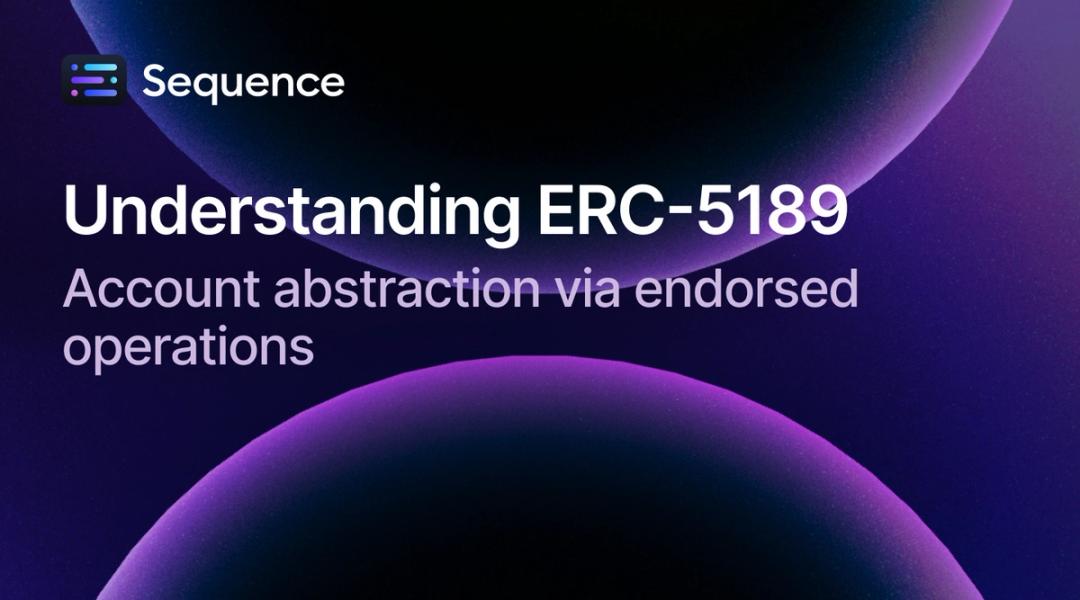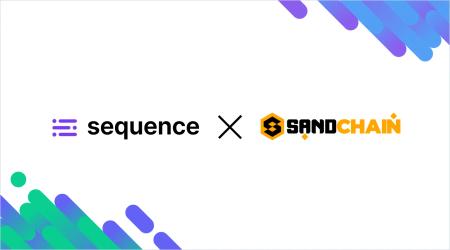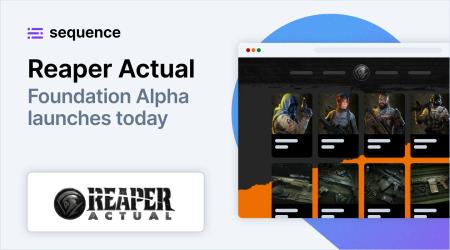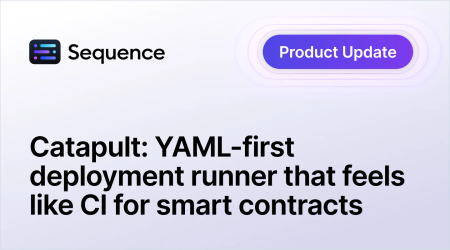Understanding ERC-5189: Account abstraction via endorsed operations
May 16 2024

ERC-5189 introduces a new framework for formatting and transmitting data, optimizing how developers handle and engage with crypto and digital assets on the blockchain.
Co-authored by members of the Sequence team Agustín Aguilar, Philippe Castonguay, and Michael Standen, ERC-5189 offers an alternate proposal to ERC-4337.
Along with a dedicated page, we've also released a demo and have made the code open-source for developers to test and explore.
This article aims to shed light on this new proposal to advance experimentation and discussion within the web3 developer community, improve existing account abstraction standards, and push the ecosystem forward.
So, what is ERC-5189?
ERC-5189 is a ready-to-use decentralized mempool. ERC-5189 proposes a form of account abstraction that ensures compatibility with existing smart contract wallets.
It provides flexibility for alternative designs while avoiding changes to the consensus layer on the blockchain, making it cheaper, more powerful, convenient, and accessible for developers.
This proposal introduces the concept of endorser contracts as an alternative to the current structure for AA transactions aligned with the current ERC-4337 format. ERC-5189 moves all of the “meta-logic” associated with transactions to independent contracts called endorsers.
Endorser contracts are specific smart contract instances designed to assess the quality of AA transactions. Their evaluation helps bundlers decide whether to retain or discard a transaction in the mempool. They’re never called on-chain, during a transaction, and are free to use.
To ensure compatibility with this ERC standard, developers integrating their smart contract wallets must either create and deploy an endorser contract or utilize an existing one that aligns with their wallet's specifications. This approach enhances transaction reliability and streamlines integration without imposing a strict transaction framework.
ERC-5189 doesn’t change the consensus layer or impose changes on existing smart contract wallets, so developers have no backward compatibility issues and benefit from more flexible design mechanics — and are met with a broader range than competing AA standards.
Key features of ERC-5189
ERC-5189 achieves the primary goal of account abstraction, allowing users to relay smart contract wallet transactions using a decentralized mempool.
ERC-5189 unlocks the potential of zero-cost account abstraction with:
1. Simpler and more flexible wallets: Wallets have more freedom in how they operate. This ERC avoids restrictions on functionalities, allowing developers to build innovative features.
2. Easy adoption for existing wallets: No changes are required for existing wallets to be compatible. This ensures a smooth transition and avoids disruption for current users.
3. Reduced gas fees for users: Transaction validation happens off-chain, so users don't pay extra gas for this security measure.
4. Safer bundler operations: "Endorser" contracts validate transactions before bundlers include them, minimizing the risk of including malicious transactions.
5. Decentralized and dynamic endorser system: Anyone can create an endorser, fostering competition and innovation. Bundlers can choose reliable endorsers based on a public registry.
Why is ERC-5189 important?
ERC-5189 enables all smart wallets to relay transactions without using a centralized relayer. It ensures smooth communication between wallet developers and mempool operators, allowing them to "understand" if the operations are “healthy” or not.
While ERC-5189 solves the same challenges as ERC-4337, it proposes a framework with different trade-offs.
"ERC-5189 is a fresh take and alternative to ERC-4337 standard, aimed at keeping "blank slate" freedoms when building smart contract wallets. Although it requires a trade-off in operational simplicity for mempool operators, it maintains the adaptability needed to support both previous and current wallets, as well as facilitate the integration of future ideas."
Agustín Aguilar, Head of Research @ Sequence
The future of ERC-5189 and beyond
ERC-5189 represents a significant step forward in the standardization of AA mempools. Sequence has open-sourced ERC-5189’s code for the community and continues to welcome feedback and suggestions to improve.
Developer resources to get started with ERC-5189:
- Explore our Sendify demo to send any ERC-20 token without owning any ETH with any web3 wallet
- Run a bundler using our open-source reference bundler
For users on the lookout for more detailed information and updates on ERC-5189, visit the official site and learn more here.
Sequence makes building onchain simple. Developers and teams can launch, grow, and monetize apps with unified wallets, 1-click cross-chain transactions, and real-time data, all in a modular and secure stack. No more stitching together fragmented tools or battling poor user flows. Sequence is production-ready infrastructure that helps teams ship faster, onboard more users, and scale confidently. From chains and stablecoins to DeFi and gaming, Sequence powers developers and applications across the EVM ecosystem with billions in transaction volume and millions of users. Trusted by leaders in blockchain, Sequence powers today’s onchain apps and delivers future-proof infrastructure for tomorrow’s breakthroughs. Learn more at sequence.xyz.
Written by

Agustin Aguilar
Director of Blockchain Research at Sequence
Philippe Castonguay
Head of Product @ Horizon Blockchain Games and Sequence
Michael Standen
Senior Smart Contract Engineer @ SequenceRelated Posts

In partnership with KOR Protocol, Sequence and Msquared, Black Mirror's franchise has launched the $MIRROR token and a new web3 experience!

With SANDchain and Sequence, along with the launch of SANDchain Builder, creators now have everything they need to launch and scale web3 experiences!

We’re thrilled to announce that Reaper Actual goes live today, October 8, with the launch of its Foundation Alpha. And it's powered by Sequence!

We're thrilled to announce the launch of Catapult, a revolutionary tool that simplifies and automates your smart contract deployment process!

